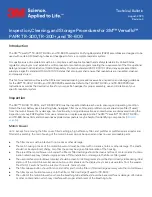
3
3M Personal Safety Division
Battery Charger
•
Inspect the power base and cradle for cracks or other damage.
•
Inspect the power cord for frayed wires or other damage.
•
Ensure the gold electrical contacts are clean, dry and free of debris.
•
Gently push on each of the gold contact pins. They should easily push down and quickly pop back up.
•
Ensure the charger tray is clean, dry and free of debris.
Headgear
•
Inspect headgear based on the headgear specific
User
Instructions
.
Cleaning
The TR-300, TR-300+, and TR-600 should be cleaned regularly. Follow the hygiene practices established for your worksite
for the specific contaminants to which the respirator assembly has been exposed.
Motor/blower unit and battery pack
•
Do not use organic solvents (i.e. toluene, paint thinner) or abrasive cleaners as they may weaken and damage the plastic.
Do not use cleaners that leave a residue. Do not allow liquid to enter the air inlet port or breathing tube port.
•
Do not use compressed air or a vacuum to clean the interior of the motor/blower. This can damage the motor/blower.
•
Use caution when cleaning around the battery pack connector pins where the battery seats on the bottom of the motor/
blower unit to avoid pins from bending, breaking, or introducing debris into the pin housing. Ensure this area and the
pins are thoroughly dry before next use or storage.
Wipe Down Cleaning
•
The outer surfaces of the TR-300, TR-300+, and TR-600 motor/blower assembly and battery pack (still attached) may
be wiped with a soft cloth dampened in a solution of water and mild, pH neutral detergent. In general, many commonly
used water-based hard-surface cleaners may also be used that will not damage the PAPR system. See Table A for a list
of tested cleaners and their effects.
Do
not
attempt
to
clean
the
battery
connection
pins
on
the
blower
or
the
blower/charger connection pads on the battery – these are coated and direct cleaning with moist cloths or
wipes should be avoided.
Submersion Cleaning (TR-600 only)
With the blower inlet and outlet plugs installed the TR-600 PAPR has an International Protection or Ingress Protection (IP)
rating of IP67 (EN 60529: 1992). The TR-600 batteries also have an IP67 rating. The IP67 rating indicates the unit is protected
against infiltration of dusts and water that would interfere with normal operation when immersed in water up to 1 meter (3
feet) for up to 30 minutes. However, best practice would be to limit immersion to the shallowest depth and shortest time
required for effective cleaning.
•
If submersion cleaning is desired, remove the filter/cartridge and breathing tube. To minimize material falling onto the
motor/blower, remove the filter/cartridge and breathing tube while each of those connections are facing downward.
Attach the air inlet and air outlet cleaning and storage plugs (3M™ Cleaning and Storage Kit TR-653) into the TR-600
(see Fig 1). The TR-600 can now be rinsed under running water, submersed in water, or put in a respirator washer for
further cleaning. Water temperature should not exceed 122°F (50°C). Blowers which have been dropped or damaged












